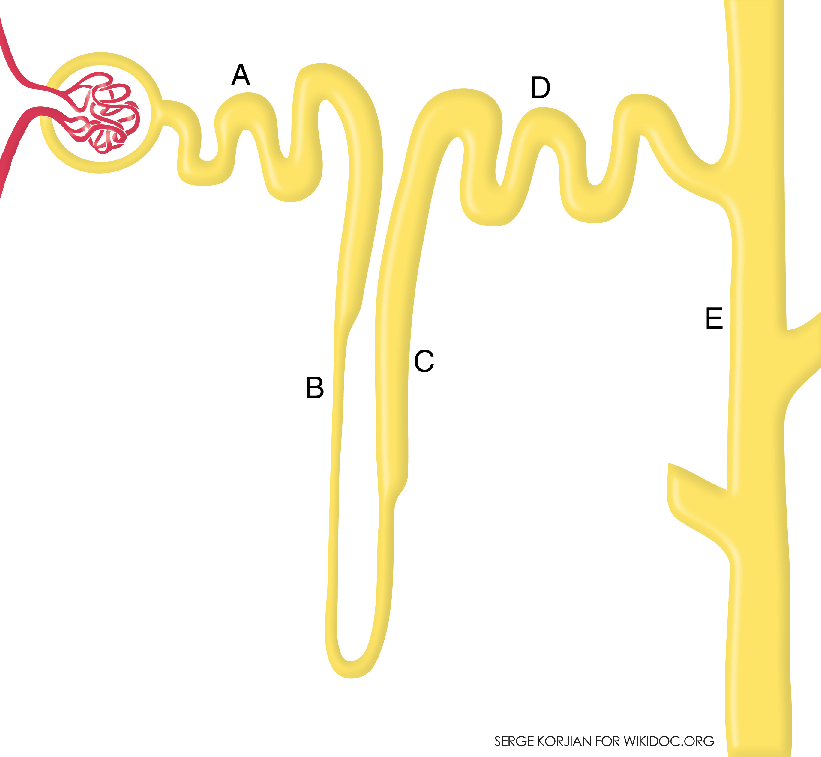WBR0511
Jump to navigation
Jump to search
| Author | [[PageAuthor::Yazan Daaboul, M.D. (Reviewed by Serge Korjian)]] |
|---|---|
| Exam Type | ExamType::USMLE Step 1 |
| Main Category | MainCategory::Physiology |
| Sub Category | SubCategory::Renal |
| Prompt | [[Prompt::A researcher is studying renal calcium dynamics along the length of a nephron. He conducts an experiment by sampling filtrate samples at various levels along the renal tubules. He notices that after filtration, more than 90% of calcium is reabsorbed by passive and active mechanisms. Additionally, he notes that calcium reabsorption is dependent on the hormonal effects of parathyroid hormone (PTH). Using the illustration below, which segment of the nephron is responsible for the PTH-mediated reabsorption of calcium? |
| Answer A | AnswerA::A |
| Answer A Explanation | [[AnswerAExp::"A" corresponds to the proximal convoluted tubules. This is not the location where PTH acts to increase the reabsorption of calcium. However, this is the location where the sodium/phosphate co-transporter is inhibited to further excrete phosphate and decrease serum concentrations of phosphate.]] |
| Answer B | AnswerB::B |
| Answer B Explanation | AnswerBExp::"B" corresponds to the descending loop of Henle. This is not the location where PTH acts to increase the reabsorption of calcium. |
| Answer C | AnswerC::C |
| Answer C Explanation | AnswerCExp::"C" corresponds to the ascending loop of Henle. This is not the location where PTH acts to increase the reabsorption of calcium. |
| Answer D | AnswerD::D |
| Answer D Explanation | AnswerDExp::"D" corresponds to the distal convoluted tubule. This is the location where PTH-mediated calcium reabsorption occurs. |
| Answer E | AnswerE::E |
| Answer E Explanation | AnswerEExp::"E" corresponds to the collecting ducts. This is not the location where PTH acts to increase the reabsorption of calcium. |
| Right Answer | RightAnswer::D |
| Explanation | [[Explanation::Calcium homeostasis is essential for muscular and neural function as well as osteogenesis. It is maintained in physiological concentrations under the control of parathyroid hormone (PTH). Low serum calcium promotes the secretion of PTH into the circulation allowing 3 main processes to occur: (1) increased calcium and phosphate release from bone, (2) increased calcium reabsorption/phosphate excretion in the renal tubules, and (3) increased calcium and phosphate reabsorption from the small intestine secondary to the PTH mediated increase in 1,25(OH)Vitamin D3. Accordingly, PTH increases the serum concentrations of calcium. The increase in calcium above a set threshold acts as an inhibitor of PTH secretion by a negative-feedback loop. In the kidneys, PTH inhibits the sodium/phosphate co-transporter in the proximal convoluted tubules to promote phosphate excretion (decrease its reabsorption). In converse, it increases the calcium/sodium exchanger in the distal convoluted tubule to increase calcium reabsorption and thus increase the serum concentrations of calcium. Educational Objective: PTH increases the calcium/sodium exchanger in the distal convoluted tubules to increase the reabsorption of calcium. |
| Approved | Approved::Yes |
| Keyword | WBRKeyword::Calcium, WBRKeyword::Renal calcium handling, WBRKeyword::Kidney, WBRKeyword::PTH, WBRKeyword::Parathyroid hormone, WBRKeyword::Phosphate, WBRKeyword::Distal convoluted tubule, WBRKeyword::Proximal convoluted tubule, WBRKeyword::Electrolyte homeostasis |
| Linked Question | Linked:: |
| Order in Linked Questions | LinkedOrder:: |
